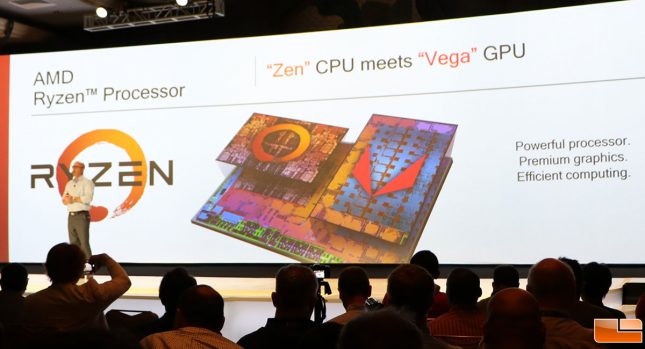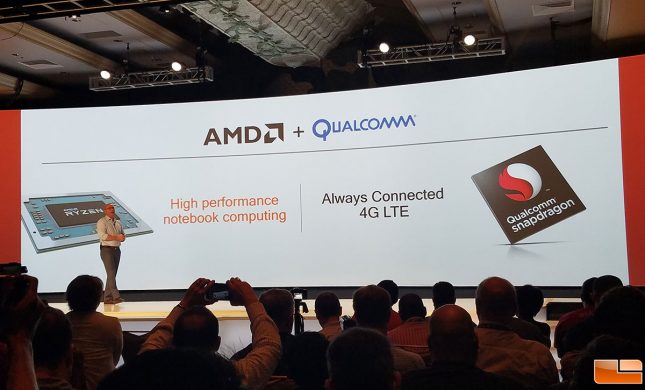AMD To Use Qualcomm Tech For Always Connected PCs on Ryzen Mobile Platforms
AMD and Qualcomm Technologies to Support Always Connected PCs on Ryzen Mobile Platforms
AMD Ryzen Mobile Processors and Qualcomm Snapdragon LTE Modem Solutions to Provide Gigabit Class Connectivity for High-Performance Consumer and Enterprise Notebook Platforms
SUNNYVALE, Calif. December 5, 2017 AMD (NASDAQ: AMD) today announced that they are working with Qualcomm Technologies, Inc. (NASDAQ: QCOM) to bring smooth and fast PC connectivity solutions to AMDs high-performance Ryzen mobile processors, featuring the worlds fastest processor for ultrathin notebooks[i]. With Qualcomm Snapdragon LTE modem solutions, AMD and Qualcomm Technologies will help make it easy for the leading global PC companies to create premium computing platforms with Always Connected, Gigabit LTE speeds alongside the AMD Ryzen mobile processors blazingly fast performance, fluid graphics rendering, and optimal efficiency.
Both AMD and Qualcomm have shown a consistent commitment to delivering products that redefine next-generation mobile user experiences, said Kevin Lensing, corporate vice president and general manager, client computing, AMD. OEMs around the world will now be able to combine the recently announced AMD Ryzen mobile processors with Qualcomm Technologies leading wireless solutions via their Snapdragon LTE modem family to achieve new levels of performance, connectivity and capability for ultrathin notebook PCs.
Qualcomm Technologies believes the Always Connected PC is the future of personal computing, and we are working with AMD to bring each companys expertise to bear for these exciting products, said Alex Katouzian, senior vice president and general manager, mobile, Qualcomm Technologies, Inc. Combining AMD processors with our cutting-edge LTE connectivity technology results in Always Connected Client Notebooks for consumers in a mobile-first future.
AMD Ryzen Mobile Processor with Radeon Vega graphics:
- Leadership performance: Featuring the Worlds fastest processor for ultrathin notebooks1, AMD Ryzen mobile processor provides unprecedented performance up to 2.7X[ii] the CPU performance and up to 2.2X[iii] the GPU performance generationally
- Complete entertainment experience: Outstanding gaming in popular eSports titles & ready to power the most advanced & beautiful displays including HDR[iv], Radeon FreeSync 2[v], and 4K[vi]monitors
- Focused on amazing battery life: Targeting up to a 2X battery life improvement[vii] generationally
Qualcomm Snapdragon LTE Modem Solutions Engineered to Offer:
- Support some of the latest wireless network technologies[viii]
- Blazing-fast LTE download speeds[ix]
- Superior speeds in weak signal conditions[x]
- Long battery life
Supporting Resources
- Learn more about AMD Ryzen Mobile processors at AMD.com/RyzenMobile
- Learn more about the Zen core architecture at AMD.com/Zen
- Learn more about the AMD Radeon RX Vega Series
- Learn more about the AMD 25X20 Energy Efficiency Initiatives
- Learn more about AMD Products, Solutions, and Innovations
- Become a fan of AMD on Facebook
- Follow AMD on Twitter @AMD
About AMD
For more than 45 years, AMD has driven innovation in high-performance computing, graphics, and visualization technologies the building blocks for gaming, immersive platforms, and the datacenter. Hundreds of millions of consumers, leading Fortune 500 businesses, and cutting-edge scientific research facilities around the world rely on AMD technology daily to improve how they live, work, and play. AMD employees around the world are focused on building great products that push the boundaries of what is possible. For more information about how AMD is enabling today and inspiring tomorrow, visit the AMD (NASDAQ: AMD) website, blog, Facebook and Twitter pages.
[i] Processor for ultrathin laptops defined as 15W nominal processor TDP. Based on testing of the AMD Ryzen 7 2700U, AMD Ryzen 5 2500U, and Core i7-8550U 15W mobile processors as of 10/6/2017. Performance based on Cinebench R15 nT (CPU performance) and 3DMark TimeSpy (GPU performance) in order of AMD Ryzen 7 2700U, AMD Ryzen 5 2500U and Intel 8550U. AMD Ryzen 7 2700U: AMD Reference, AMD Ryzen 7 2700U with Radeon Vega 10 Processor Graphics, 8GB DDR4-2400 RAM, Samsung 850 PRO 512GB SATA SSD, Windows 10 Pro RS2, Graphics driver 23.20.768.9, 26-Sep-2017
[ii] Testing by AMD Performance labs. PC manufacturers may vary configurations yielding different results. Cinebench R15 nT is used to simulate multi-thread CPU performance; the AMD Ryzen 7 2700U scored 660.5, while the FX 9800P scored 240 for a benchmark score comparison of 660.5/240 = 2.75X or 175% more. System Configurations: AMD Ryzen 7 2700U Processor: HP 83C6, AMD Ryzen 7 2700U Mobile Processor with Radeon Vega 10 Graphics, 8GB Dual Channel (2x4GB) DDR4-2400 RAM, Samsung 850 PRO 512GB SATA SSD, Windows 10 Pro RS2, Graphics driver 22.19.655.2, 06-Sep-2017AMD FX 9800P: HP 81AA, AMD FX 9800P with Radeon R7 Mobile Graphics, 8GB Single Channel (1x8GB) DDR4-2133 RAM, Samsung 850 PRO 512GB SATA SSD, Windows 10 Pro RS2, Graphics driver 22.19.662.4, 19-Jul-2017. RVM-27
[iii] Testing by AMD Performance labs. PC manufacturers may vary configurations yielding different results. Performance may vary with driver versions. AMD Ryzen 7 2700U: AMD Reference, AMD Ryzen 7 2700U with Radeon Vega 10 Processor Graphics, 8GB DDR4-2400 RAM, Samsung 850 PRO 512GB SATA SSD, Windows 10 Pro RS2, Graphics driver 23.20.768.9, 26-Sep-2017. AMD FX 9800P: HP 81AA, AMD FX 9800P with Radeon R7 Mobile Graphics, 8GB DDR4-2133 RAM, Samsung 850 PRO 512GB SATA SSD, Windows 10 Pro RS2, Graphics driver 22.19.662.4, 19-Jul-20173DMark Time Spy is used to simulate graphics performance; the AMD Ryzen 7 2700U scored 915, while the AMD FX 9800P scored 400 for a benchmark score comparison of 915/400 = 2.29X or 129% more performance. RVM-17
[iv] HDR content requires that the system be configured with a fully HDR-ready content chain, including: graphics card, monitor/TV, graphics driver and application. Video content must be graded in HDR and viewed with an HDR-ready player. Windowed mode content requires operating system support. GD-96
[v] FreeSync 2 does not require HDR capable monitors; driver can set monitor in native mode when FreeSync 2 supported HDR content is detected. Low-latency HDR only attainable when using a FreeSync 2 API enabled game or video player and content that uses at least 2x the perceivable brightness and color range of sRGB, and using a FreeSync 2 qualified monitor. Based on AMD internal testing as of November 2016. GD-105.
[vi] Requires 4K display and content. Supported resolution varies by GPU model and board design; confirm specifications with manufacturer before purchase. GD-113
[vii] Based on AMD testing as of 10/11/2017. Battery life targets for the AMD Ryzen Processor with Radeon Graphics assume a 50Wh battery, a fully power-optimized software/hardware solution stack, and the following system configuration: AMD Reference Platform, AMD Ryzen 7 2700U, 2x4GB DDR4-2400, graphics driver 17.30.1025, Windows 10 x64 (1703). 1080p H.264 battery life tested at 10.6 hours for the AMD FX 9800P and targeted at 12.2 hours for the Ryzen 7 2700U. Mobile Mark battery life tested at 10.7 hours for the AMD FX 9800P and targeted at 13.5 hours for the Ryzen 7 2700U. VP9 battery life improvement of 4.5 hours to 9.2 hours represents 2.04. Actual battery life may vary with system configuration.
[viii] Snapdragon LTE modems support up to Category 18 LTE, the most advanced LTE capability available on commercial networks, as well as technologies such as 4×4 MIMO and License Assisted Access (LAA)
[ix] Devices with Snapdragon Gigabit LTE can achieve an average of 100-300Mbps real world download speeds on supporting networks.
[x] Devices with Snapdragon Gigabit LTE, including 4×4 MIMO support, can achieve up to 70% faster download speeds compared to 2×2 MIMO devices in weak signal conditions (20dB SNR and below).


